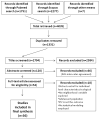Neighborhood environment and intimate partner violence: a systematic review
- PMID: 24370630
- PMCID: PMC4476540
- DOI: 10.1177/1524838013515758
Neighborhood environment and intimate partner violence: a systematic review
Abstract
Intimate partner violence (IPV) is an important global public health problem, affecting women across the life span and increasing risk for a number of unfavorable health outcomes. Typically conceptualized as a private form of violence, most research has focused on individual-level risk markers. Recently, more scholarly attention has been paid to the role that the residential neighborhood environment may play in influencing the occurrence of IPV. With research accumulating since the 1990s, increasing prominence of the topic, and no comprehensive literature reviews yet undertaken, it is time to take stock of what is known, what remains unknown, and the methods and concepts investigators have considered. In this article, we undertake a comprehensive, systematic review of the literature to date on the relationship between neighborhood environment and IPV, asking, "what is the status of scholarship related to the association between neighborhood environment and IPV occurrence?" Although the literature is young, it is receiving increasing attention from researchers in sociology, public health, criminology, and other fields. Obvious gaps in the literature include limited consideration of nonurban areas, limited theoretical motivation, and limited consideration of the range of potential contributors to environmental effects on IPV--such as built environmental factors or access to services. In addition, explanations of the pathways by which place influences the occurrence of IPV draw mainly from social disorganization theory that was developed in urban settings in the United States and may need to be adapted, especially to be useful in explaining residential environmental correlates of IPV in rural or non-U.S. settings. A more complete theoretical understanding of the relationship between neighborhood environment and IPV, especially considering differences among urban, semiurban, and rural settings and developed and developing country settings, will be necessary to advance research questions and improve policy and intervention responses to reduce the burden of IPV.
Keywords: community violence; cultural contexts; domestic violence.
© The Author(s) 2013.
Figures



References
-
- Ackerson LK, Subramanian SV. State Gender Inequality, Socioeconomic Status and Intimate Partner Violence (IPV) in India: A Multilevel Analysis. Australian Journal of Social Issues. 2008;43(1):81–102. Article.
-
- Aklimunnessa K, Khan MMH, Kabir M, Mori M. Prevalence and correlates of domestic violence by husbands against wives in Bangladesh: evidence from a national survey. Journal of Men's Health and Gender. 2007;4(1):52–63.
-
- Alhabib S, Nur U, Jones R. Domestic violence against women: systematic review of prevalence studies. Journal of Family Violence. 2010;25(4):369–382.
Publication types
MeSH terms
Grants and funding
LinkOut - more resources
Full Text Sources
Other Literature Sources

